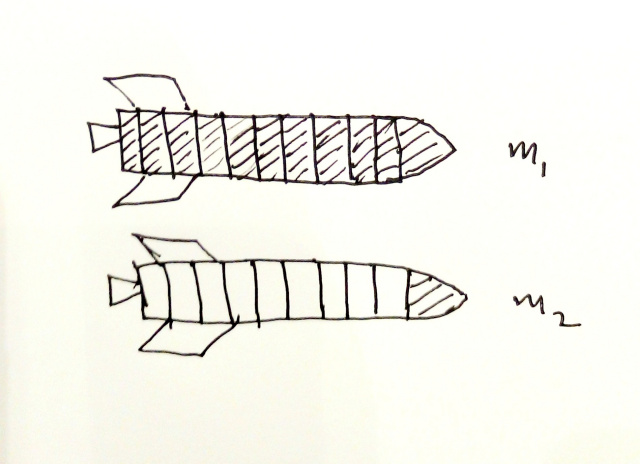
90 percent of mass gone!
We are going to calculate about reaching Low Earth Orbit (LEO). This is about 200 km above the surface of the Earth. For our calculation we will use the distance from the centre of the Earth, by adding the radius of Earth, 6371 km to it. Thus LEO is 6571 km from the centre of the Earth.
Initial velocity at equator (from Earth rotation) v=464 m/s. Earth's surface is 6371 km from the centre.
What we want to do, is a speed up until you reach apogee, at 6571km (from centre of Earth, or 200km above the surface). Then do another burst, adding 60m/s.
The first part requires a velocity of 7966.7 m/s. We need Delta V of 7502.7 m/s.
When that velocity is attained, the rocket climbs to apogee, 200km above, slowing down to 7724 m/s.
A circular orbit at LEO needs a velocity of 7784 m/s, so we need to add 60m/s to attain circular orbit.
How do we know these values? We will explore this later in the Vis-Viva Equation. Right now we want the fuel consumption, the percentage of mass that must consist of fuel.
Initially we want delta V of 7502.7 m/s, then a kick of an additional 60 m/s.
$$ \Delta V = V_e log\left(\frac{m_1}{m_2}\right) $$
Rearranging that,
$$ \frac{m_1}{m_2} = e^{\frac{\Delta v}{V_e}} $$
$$ \frac{m_1}{m_2} = e^{\frac{7502.7}{3000}} \frac{m_1}{m_2} = 12.2 $$
The intial mass of the ship, full of fuel, must be about 12.2 times the mass of it after reaching orbit. m_1:m_2 = 1: 12.2. Ship:Fuel = 1:11.2.
$$ \frac{11.2}{12.2} \approx 0.92 $$
So that the fuel mass must be about 92 percent of the initial mass m_1 of the rocket, just to raise the ship to LEO altitude.

90 percent of mass gone!
Additional 60 m/s is almost trivial.
$$ \frac{m_1}{m_2} = e^{\frac{60}{3000}}$$ $$ \frac{m_1}{m_2} = 1.02 $$ $$ \frac{fuel}{ship} = 0.02$$
Of the remaining mass the fuel needs only to be 2 percent.
Geostationary orbit is a special orbit, much higher the LEO. Something orbiting at this distance from Earth (above the equator, ideally) will take 24 hours to orbit the planet. From the point of view of someone on Earth, it is as if the satellite is hovering above him.
This orbit is 42,177 km from the centre of the Earth.
Normally a rocket goes to LEO first. Then it fires its engines to (perigee speed), and shuts engines. The rocket climbs to new apogee just using momentum, reaching the height of Geostationary orbit, slowing down. Then the engine is fired again, adding (speed to make Geostationary) to make the orbit circular.
LEO 7784 m/s at 6571 km from centre of Earth.
First we need to boost to 10240 m/s, which is a delta v of 2456 m/s. This turns the circular orbit into an elliptical one, whose highest point, the apogee, touches the circle of the Geostationary orbit.
$$ e^{\frac{\Delta v}{V_e}} = \frac{m_1}{m_2} $$
Assuming the exhaust velocity is 3000 m/s:
$$ \frac{m_1}{m_2} = e^{\frac{2456}{3000}} = 2.27 $$
The mass of the ship before the burn is 2.27 times that of the ship after the burn. Substantial, but not as bad as launching to LEO.
The amount of fuel needed is 1.27 times the mass of the ship after the burn.
The ship then coasts to the apogee on its inertia, slowing down to 1596 m/s.
Once it reaches apogee, the ship fires its engines again to circularise the orbit at Geostationary orbit, moving at 3072 m/s. The delta v is 1476 m/s.
$$ \frac{m_1}{m_2} = e^{\frac{1476}{3000}} = 1.64 $$
The initial mass before burn is 1.64 times the mass after the burn.
The fuel mass is 64 percent of the ship.
As you can imagine, the mass of the ship that actually arrives at Geostationary orbit is quite small.